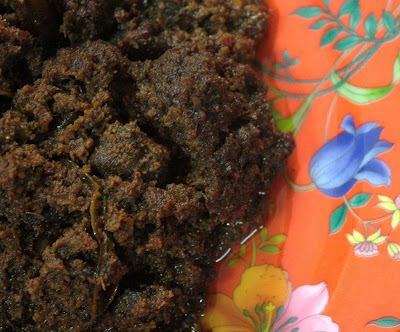A biryani requires saffron. A spice I hardly use but had the pleasure of using when I made this.
In using saffron i realized that crushing the saffron threads to a powder before soaking them in some hot water is a must if you want the intense crimson liquid to bloom to its fullest and to speckle the rice as if it had caught bits and pieces of golden sunlight here and there making the biryani rice quite attractive.
The second time I made biryani I had not crushed the saffron to a powder and all I got was a yellow hue that made the biryani rice look as if i had cooked the rice in tumeric tinted water. Which is ok if I was making tumeric rice of course....but not if it was a biryani.
Ghee or clarified butter adds so much flavour as well giving it the distinctive biryani taste. This too I had discovered when I had omitted using ghee the second time around.
Now I know why rules are meant to be broken. It convinces you that they shouldn't be.
Unlike the true Indian biryani where the rice and meat is layered and cooked in one pot, with the lid sealed tightly to the pot with a flour and water dough in order to retain as much moisture as possible within, I had instead cooked them seperately because I didn't trust myself.
You could of course layer the meat and rice after both have been cooked seperately, sprinkle some fried onions, chopped coriander leaves, squirts of lime juice in between each layer and let the mixed dish sit over a slow flame, covered, for an extra 5 minutes to infuse the flavours and serve thus.
If you had a three tiered tiffin carrier a simple salad of sliced cucumbers and pineapple could be included and you would have a complete biryani meal.
The recipe ~
The recipe ~
The biryani rice ~ from Delicious magazine
Vegetable oil
4-5 shallots, sliced thinly
11/2 cups basmati rice
3 T ghee
1 tsp cumin seeds
5 cardamom pods
5-6 cloves
1 inch cinnamon stick
2 dried bay leaves
1/3 cup sultanas
1/3 cup cashews (optional)
A pinch of saffron thread
Fry the finely sliced shallots until golden and crispy. Drain of kitchen paper and keep aside.
Wash the rice at least three times until the water is clear and to rid of excess starch. Drain over a fine sieve. Keep aside.
Heat a medium deep pot. Melt the ghee, Saute the cumin, cardamom pods, cloves, cinnamon stick, bay leaves, sultanas, cashews (if using) and a teaspoon of salt for a few seconds. Add washed rice and stir until the rice is evenly coated by the ghee. Add 2 cups (500 ml) of boiling water. Bring to the boil, reduce to a simmer and cook for about 15 minutes.
Meanwhile pound the saffron until a powder, scoop into a small bowl and add a teaspoon of hot water.
Uncover the rice pot after 15 minutes and dribble the saffron water over the rice. Cover again and let the rice cook over a very allow heat for about 2-3 minutes. Turn off the heat and keep half covered to allow the rice to dry a little. Sprinkle the fried shallots over the rice once transferred to a platter.
The meat biryani ~adapted from Indian Cooking by Lalita Ahmed
½ kg beef fillet, sliced thickly or into 1 inch cubes
3 yellow onions
1 bay leaf
1 inch cinnamon stick
4 cardomoms
6 cloves
1 inch ginger, pounded
2-3 cloves garlic
1//2 tsp turmeric powder
2 tsp ground coriander
2 tsp ground cumin
1 tsp chilli powder
½ cup plain yogurt
1 teaspoon salt
1/3 cup cashews, roasted and ground finely
A pinch of saffron thread, pounded and soaked in 1 T of hot water to release the colour
A sprig of coriander leaves, chopped
About 1 cup of water
3 -4 T ghee
To finish :
1/4 cup of crispy fried shallots,
Some chopped coriander leaves
Heat a medium deep pot. Melt the ghee, add the sliced onions and sauté until golden brown. Then add the bay leaf, cinnamon, cloves and cardamom. Saute until fragrant for about 30 seconds.
Then add the meat, ginger, garlic, turmeric, the ground spices, chiili powder and yogurt. Stir to incorporate the spices all over the meat. Cover and cook until dry and the oil seperates from the mixture.
Add water, ground cashews and continue cooking for 40-50 minutes or until the meat is tender. There should be 4-5 tablespoons of thick sauce. Add the chopped coriander leaves and saffron liquid and stir to mix in. Taste for salt and adjust if necessary.
Before serving sprinkle the fried shallots over the dish and some chopped coriander leaves























